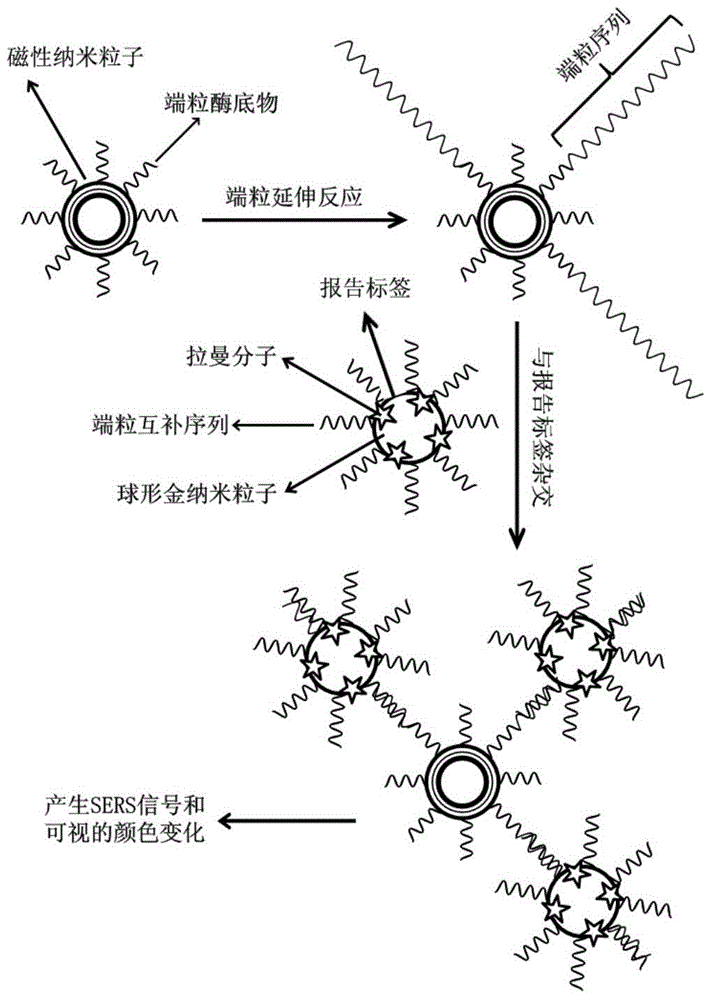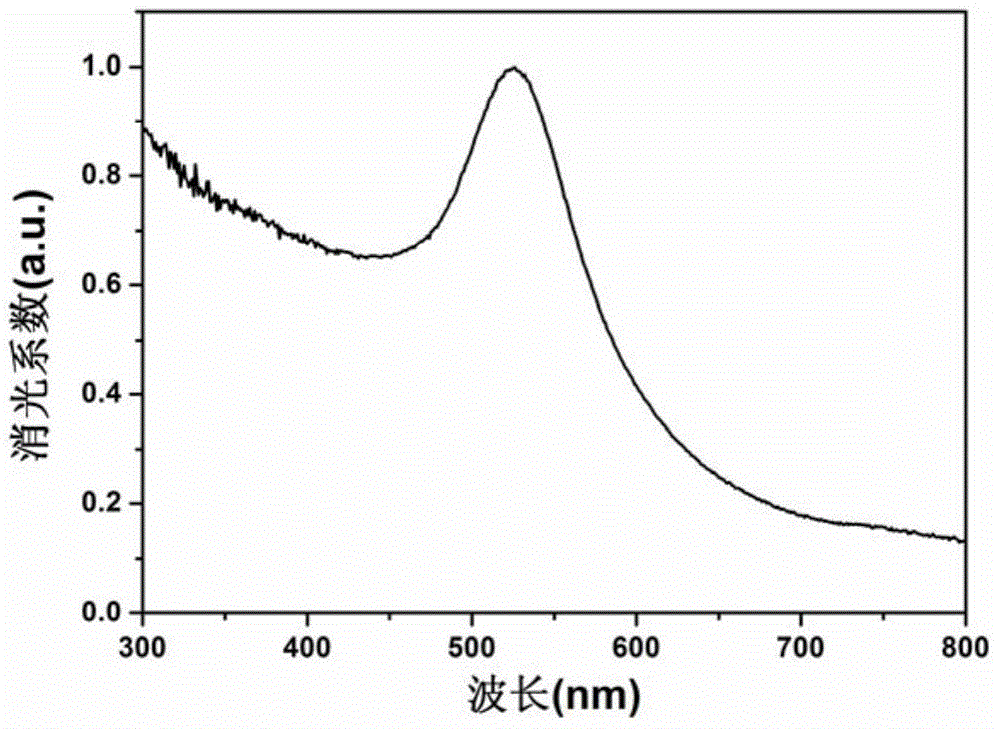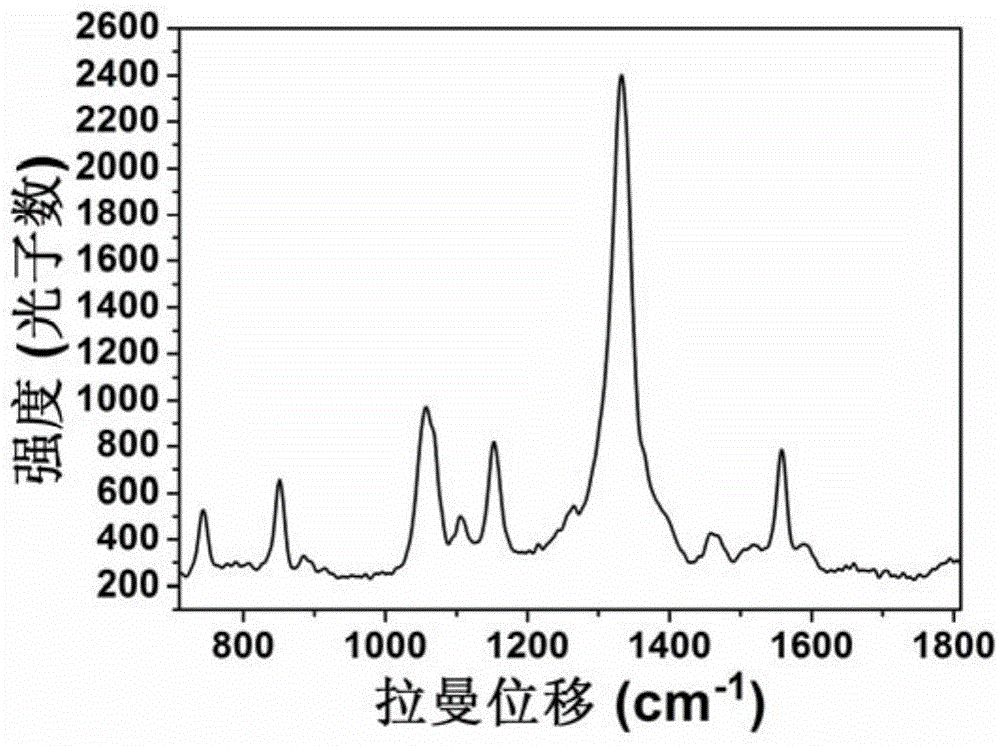A method for detecting telomerase activity
A technology for activity detection and telomerase, which is applied in biochemical equipment and methods, microbial measurement/inspection, Raman scattering, etc., can solve problems such as high cost, low sensitivity of telomerase activity detection, and complicated procedures, and achieve Improve reliability, simplify the detection steps of telomerase activity, and avoid the effect of PCR reaction process
- Summary
- Abstract
- Description
- Claims
- Application Information
AI Technical Summary
Problems solved by technology
Method used
Image
Examples
preparation example Construction
[0044] The preparation method of described capturing base comprises the following steps:
[0045] The first step is to prepare iron ferric oxide nanoparticles by solvothermal method;
[0046] In the second step, the improved The method wraps the silica shell on the surface of the iron ferric oxide nanoparticles prepared in the first step, and then further modifies the surface of the silica shell with amino groups;
[0047] The third step, adopting the seed growth method to wrap the gold shell layer on the surface of the surface amino-modified silica shell wrapped iron ferric oxide nanoparticles prepared in the second step;
[0048] In the fourth step, a telomerase substrate is connected to the surface of the iron ferric oxide nanoparticles coated with gold shells prepared in the third step to obtain a capture substrate.
[0049] The preparation method of the report label comprises the following steps:
[0050] The first step, adopting sodium citrate reduction method to pre...
Embodiment 1
[0054] Using 5,5-dithiobis(2-nitrobenzoic acid) (DTNB) as the Raman molecule, human cervical cancer cells (HeLa), human breast cancer cells (SKBR3, MCF7) and normal human embryonic lung Fibroblasts (MRC5) are cells to be tested, and the method for detecting telomerase activity is carried out using the method of the present invention.
[0055] Step 1, preparation of iron ferric oxide nanoparticles
[0056] Ferric oxide nanoparticles were prepared by solvothermal method. Add 2.7g ferric chloride hexahydrate (FeCl 3 ·6H 2 O), 1g polyethylene glycol (PEG, molecular weight 200) and 3.6g sodium acetate, stirred for half an hour to make it fully mixed. Subsequently, the mixed solution was charged into a polytetrafluoroethylene reactor at 200° C. for 8 hours. The product is magnetically separated and washed repeatedly with deionized water to obtain ferric oxide nanoparticles. Disperse ferric iron tetroxide nanoparticles into 50 mL of deionized water, use argon gas to drive away t...
Embodiment 2
[0076] Using the 5,5-dithiobis(2-nitrobenzoic acid) (DTNB) molecule as the Raman molecule and human breast cancer cells (SKBR3) as the cells to be tested, the method of the present invention is used to quantify the activity of telomerase Detection experiment.
[0077] Prepare the capture substrate and the reporter label according to steps 1 to 6 in Example 1. According to the CHAPS method described in step 7 of Example 1, telomerase in SKBR3 cells was extracted, and the telomerase extract was diluted with RNase inhibitor-treated iced CHAPS lysate to correspond to 1000 cells / mL, 100 cells / mL, 10 cells / mL, 1 cell / mL. For telomere extension reaction, take 20 μL capture substrate, mix with 19 μL TRAP buffer (same as Step 4 of Example 1), 5 μL 10 mM dNTPs, 1 μL RNase inhibitor, and telomerase extracts of different cell concentrations (telomere Enzyme extracts were replaced with pure CHAPS lysate). The mixture was shaken at 30° C. for 3 h for telomere extension reaction, and the...
PUM
 Login to View More
Login to View More Abstract
Description
Claims
Application Information
 Login to View More
Login to View More - R&D
- Intellectual Property
- Life Sciences
- Materials
- Tech Scout
- Unparalleled Data Quality
- Higher Quality Content
- 60% Fewer Hallucinations
Browse by: Latest US Patents, China's latest patents, Technical Efficacy Thesaurus, Application Domain, Technology Topic, Popular Technical Reports.
© 2025 PatSnap. All rights reserved.Legal|Privacy policy|Modern Slavery Act Transparency Statement|Sitemap|About US| Contact US: help@patsnap.com



